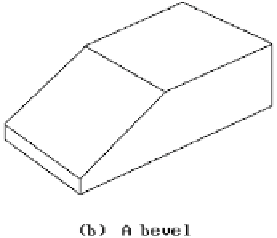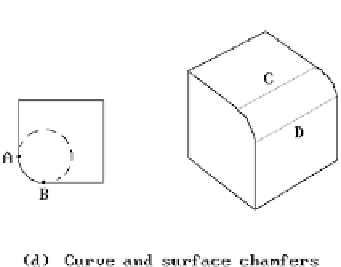Graphics Reference
In-Depth Information
Figure 5.51.
Various types of edits.
Editing involves performing operations on models. Below are some typical local
operations supported by modeling systems:
(1) extrusions, or more generally sweeps (Figure 5.51(a))
(2) beveling or defining wedges (Figure 5.51(b))
(3) blending (see Section 15.6), which is a general operation that involves finding
blending curves or surfaces.
A
blending curve
is one that smoothly connects the endpoints of two curves.
A
blending surface
is one that smoothly connects two surfaces along two given
curves, one in each surface, and meets the surfaces tangentially at those
curves.
Fillets are a special case of blending. See Figure 5.51(c). Filleting refers to a
“rounding” along an edge of a
concave
corner. This could mean, e.g., match-
ing a circle to a corner which is tangent to the edges.
Chamfering refers to “rounding” at a vertex or along a
convex
edge. See Figure
5.51(d).
The term “rounding” itself has sometimes been used to mean chamfering.
(4) local deformations of an edge or a face
(5) undoing one or more operations to restore a model to a previous state
(6) skinning (see Section 14.7)





